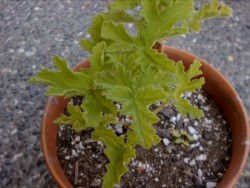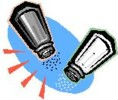Make the most of culinary herbs and spices.
Herb of the Year 2006: A Salute to Scented Geraniums
by Sandra Bowens

Just about everything I have ever read about scented geraniums makes some reference to a memory of grandmother's garden and the fragrant plant that takes the author back to childhood. I have no such memory. I am, however, enchanted by the scented geranium. I take great delight in the fact that the frilly little leaves of a houseplant can emit the aroma of nutmeg or coconut or apples. Or rose or lemon or the forest.
Rather than sprays of lavish flowers produced by the familiar true geranium, scented geraniums, Pelargonium spp., add a thrill to the garden with their aromatic foliage. Most varieties do flower. Although the blooms are often referred to as "insignificant" in garden books, they do add a dash of color to the plant or on the plate.
One garden book I have from 1974 listed 41 different scented geraniums to consider. A recent count on the Papa Geno's website revealed 141 different varieties. When I became interested in them a few years ago, they were difficult to find. Now that they have been elected the Herb of the Year for 2006 you see them in most well-stocked nurseries.
With such an abundance of variety, retail plants (and book references) are often grouped by scent types such as citrus, rose, spice or perfume. The names are usually descriptive, either of the aroma or the leaf type. Some plants will grow quite large while others remain small and delicate. They may grow upright or trailing, leaves may be rounded, or oak-like or variegated. The array of choices is truly dazzling.
Europeans have been cultivating scented geraniums since the fifteenth century when sailors brought the plants from their native South Africa. Scented geraniums captivated Thomas Jefferson who brought an assortment with him for the White House garden. The height of their popularity came during the 1800's when French chemists discovered rose scented geranium oil could be distilled and used in place of the more expensive attar of roses in perfume production. The essential oils are still used today in the perfume industry.
Scented geraniums are a gardener's dream. They thrive on heat and infrequent watering. They grow best in pots that are almost too small. Fertilizers will lessen their aroma so you need not worry about regular feeding. The plant's biggest enemy is frost. Most scented geraniums are grown as annuals although they are classified as a tender perennial. Savvy gardeners use this knowledge as an opportunity to take cuttings and bring the herb garden inside for the winter. "In fact," says Jerry Traunfeld in his Herbfarm Cookbook, "I find scented geraniums to be the easiest of all herbs to grow indoors."
Bringing the entire plant indoors during the cold season often results in leggy, unattractive plants. Stem cuttings, however, can be rooted in water and then planted in soil to start a whole new plant. This is a common method for propagation of scented geraniums as they are slow to germinate from seed.
In cooking, scented geraniums are used as a flavoring agent because the tough leaves are unpleasant to eat. Cut the leaves from the plant where they emerge from the stem. You can preserve them by making flavored sugar: alternate layers of leaves with granulated sugar and set aside for two or three weeks.
Perhaps the most popular use is to arrange larger leaves in a cake pan before pouring in the batter. As the cake bakes, the leaves perfume and flavor it but before serving they can be peeled off the top leaving a decorative imprint. Jellies are another common use for scented geraniums in the kitchen.
Outside the kitchen, think of the leaves for sachets and potpourris or create old-fashioned fingerbowls. Add them to your bathwater for a bit of aromatherapy.
You don't have to cut the leaves to enjoy them. Scented geraniums are a decorative extra in window boxes or patio plantings. Consider placing a few around your front door where visitors will brush against them. Or introduce them to your grandkids so that they will have fond memories of you and the lovely scent in their later years.
For online plant sources and more information about scented geraniums, we like these sites: Scented Geraniums of NE, Herbfresh, Mountain Valley Growers.
A Geranium by Any Name May Not be a Geranium
The fact that there are three types of geraniums serves to confuse the uninitiated as well as create miscommunications and even debate among those in the know. Within the botanical family known as Geraniaceae we have the ever-popular geranium that is grown seasonally for its big puffball flowers. Lesser known is the hardy, or cranesbill, geranium. A true perennial, the flowers are much smaller although plentiful and the plant may sometimes be found in the wild. Lastly, our scented geranium, actually a pelargonium, that is cultivated for the whimsical aromas they engender.
Here's one that's full of our favorite recipes because we wrote the book! It is also full of information, helpful hints and ideas for using herbs and spices in your kitchen.


